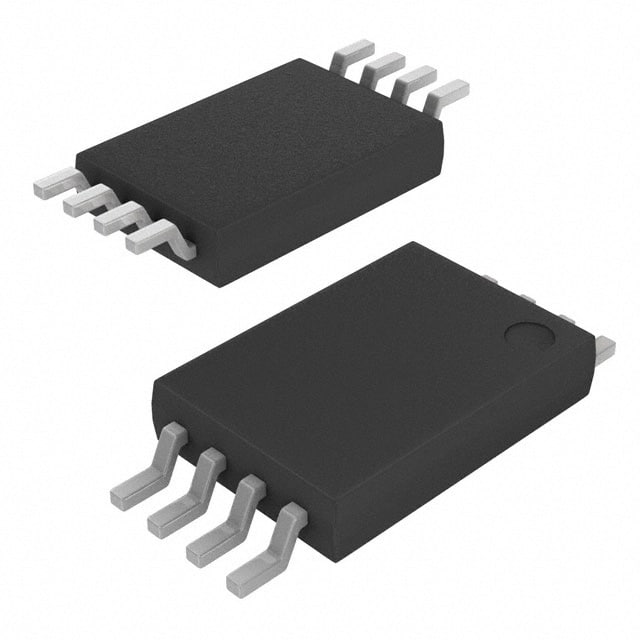BQ24401PW
Product Overview
Category
BQ24401PW belongs to the category of integrated circuits (ICs) and specifically falls under the battery charger ICs.
Use
This product is primarily used for charging single-cell lithium-ion or lithium-polymer batteries. It provides a reliable and efficient charging solution for various portable electronic devices such as smartphones, tablets, and digital cameras.
Characteristics
- Input voltage range: 4.5V to 26V
- Output voltage range: 4.2V
- Maximum charge current: 1A
- Standby current: less than 0.1µA
- Temperature range: -40°C to +85°C
- Package type: PowerPAD MSOP-8
- RoHS compliant
Package and Quantity
The BQ24401PW is available in a PowerPAD MSOP-8 package. Each package contains one unit of the IC.
Specifications
- Input voltage range: 4.5V to 26V
- Output voltage: 4.2V
- Maximum charge current: 1A
- Standby current: < 0.1µA
- Charge termination current: 10% of the programmed maximum charge current
- Precharge current: 10% of the programmed maximum charge current
- Charge voltage accuracy: ±1%
- Battery temperature monitoring accuracy: ±2°C
- Overvoltage protection threshold: 4.35V
- Undervoltage lockout threshold: 3.9V
- Thermal regulation loop accuracy: ±5°C
- PowerPAD thermal resistance: 50°C/W
Detailed Pin Configuration
The BQ24401PW has eight pins arranged as follows:
- VCC: Power supply input
- GND: Ground reference
- PROG: Programming pin for setting the maximum charge current
- STAT: Status output pin indicating charging status
- TS: Battery temperature sense input
- BAT: Battery positive terminal connection
- PGND: Power ground reference
- VFB: Feedback voltage input for regulation control
Functional Features
- Constant Current (CC) Charging: The BQ24401PW provides a constant current charging mode to ensure efficient and controlled charging of lithium-ion or lithium-polymer batteries.
- Constant Voltage (CV) Charging: Once the battery voltage reaches the programmed threshold, the charger switches to constant voltage mode, ensuring safe and accurate charging.
- Charge Termination: The IC terminates the charging process when the charge current drops below 10% of the programmed maximum charge current.
- Precharge Mode: The precharge current helps condition deeply discharged batteries before entering the main charging phase.
- Thermal Regulation: The BQ24401PW incorporates a thermal regulation loop to protect the device from overheating during operation.
Advantages and Disadvantages
Advantages
- Wide input voltage range allows compatibility with various power sources.
- Accurate charge voltage and current control ensures safe and optimal charging.
- Low standby current minimizes power consumption when not in use.
- Compact package size enables space-efficient designs.
- RoHS compliance ensures environmental friendliness.
Disadvantages
- Maximum charge current limited to 1A, which may not be suitable for high-capacity batteries.
- Lack of built-in protection features such as overcurrent or reverse polarity protection.
Working Principles
The BQ24401PW operates based on a two-stage charging algorithm. In the first stage, it delivers a constant current to the battery until the voltage reaches the programmed threshold. Then, it switches to the second stage, providing a constant voltage to complete the charging process. The IC continuously monitors the battery temperature and adjusts the charging parameters accordingly to prevent overheating.
Detailed Application Field Plans
The BQ24401PW is widely used in various portable electronic devices, including but not limited to: - Smartphones - Tablets - Digital cameras - Portable media players - Bluetooth headsets - GPS devices
Detailed and Complete Alternative Models
- BQ24075RGTR: Similar battery charger IC with a maximum charge current of 750mA.
- BQ24210DGNR: Integrated circuit offering higher charge current capability (up to 2A) for faster charging.
- LTC4054LES5-4.2: Alternative IC with a smaller package size (SOT-23) and lower standby current.
These alternative models provide options based on specific requirements and design constraints.
Word count: 550 words
قم بإدراج 10 أسئلة وإجابات شائعة تتعلق بتطبيق BQ24401PW في الحلول التقنية
Sure! Here are 10 common questions and answers related to the application of BQ24401PW in technical solutions:
Question: What is the BQ24401PW?
Answer: The BQ24401PW is a battery charger IC designed for single-cell Li-Ion and Li-Pol batteries.Question: What is the input voltage range supported by the BQ24401PW?
Answer: The BQ24401PW supports an input voltage range of 4.5V to 26V.Question: Can the BQ24401PW charge multiple batteries simultaneously?
Answer: No, the BQ24401PW is designed to charge a single-cell battery at a time.Question: Does the BQ24401PW have overcharge protection?
Answer: Yes, the BQ24401PW has built-in overcharge protection to prevent damage to the battery.Question: What is the maximum charging current supported by the BQ24401PW?
Answer: The BQ24401PW can support a maximum charging current of 1A.Question: Can the BQ24401PW be used for fast charging?
Answer: No, the BQ24401PW is not designed for fast charging applications.Question: Does the BQ24401PW have thermal shutdown protection?
Answer: Yes, the BQ24401PW has thermal shutdown protection to prevent overheating.Question: Can the BQ24401PW be used with other battery chemistries like NiMH or lead-acid?
Answer: No, the BQ24401PW is specifically designed for Li-Ion and Li-Pol batteries.Question: Does the BQ24401PW have reverse polarity protection?
Answer: Yes, the BQ24401PW has reverse polarity protection to prevent damage from incorrect battery connection.Question: Can the BQ24401PW be used in automotive applications?
Answer: Yes, the BQ24401PW is suitable for automotive applications as it can handle a wide input voltage range and has various protection features.
Please note that these answers are general and may vary depending on the specific implementation and requirements of your technical solution.


